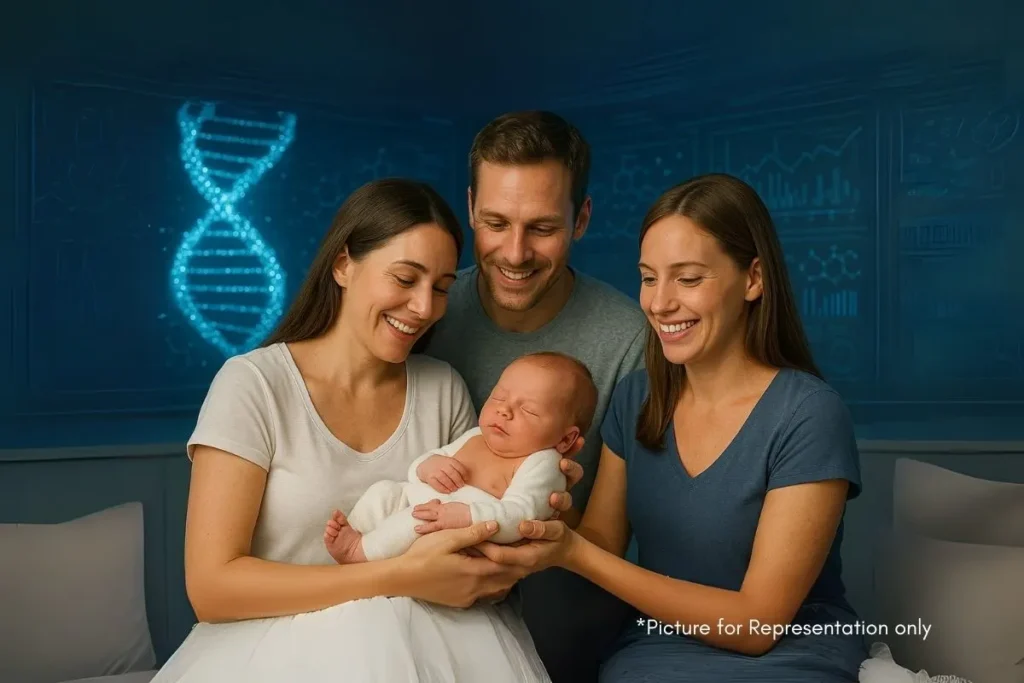What if medicine could stop a devastating disease before a baby is even born? That’s exactly what has happened in the UK, where eight babies have now been born free of mitochondrial disease, which is a previously incurable and often fatal condition. All thanks to a ground-breaking technique that involves genetic material from three people: the biological mother and father, and a female donor who contributes healthy mitochondria.
This technique, developed in Newcastle and legal in the UK since 2015, was created not for enhancement or cosmetic alterations, but to prevent suffering. Mitochondrial disorders affect approximately 1 in 5,000 births. They can cause multi-organ failure, severe neurological deficits, and tragically, many children do not survive beyond infancy. For affected families, this technique offers a chance to break a generational cycle of pain.
What Is Mitochondrial Disease and Why Is It So Serious?
Mitochondria are tiny energy-producing structures inside nearly every cell. They convert oxygen and nutrients into the energy the body needs. When mitochondria malfunction, organs like the brain, heart, muscles, and liver begin to fail. There is no cure at present, only supportive care is given.
Mitochondrial DNA is also passed down only from mother to child. So, a healthy-looking mother could still carry and transmit the faulty mitochondria to all her children. This is where mitochondrial replacement therapy (MRT) comes in, it allows parents to have a biological child without passing on this potentially deadly disorder.
How does this “three-parent baby” technique work?
The technique is scientifically referred to as mitochondrial donation. It involves taking eggs from the biological mother and a healthy female donor. Both eggs are fertilised with the father’s sperm in the lab. Then, doctors remove the nuclear genetic material (which determines features like height and eye colour) from the mother’s fertilised egg and transfer it into the donor’s fertilised egg, which still has healthy mitochondria but has had its own nucleus removed.
The resulting embryo contains over 99.9% of the parents’ DNA, and only a tiny fraction (about 0.1%) from the donor. But that 0.1% is so vital that it powers every cell in the child’s body.
Are the Babies Healthy?
So far, all eight children including four boys and four girls, and a pair of twins were born without mitochondrial disease and are reaching developmental milestones. In one case, a child had a seizure disorder that resolved spontaneously. Another one, has a mild heart rhythm issue that is under treatment. These are not currently believed to be caused by the procedure.
Although the medical teams are closely monitoring these children to understand long-term outcomes, the initial data offers reassurance and hope for future procedures.
What are the Parents Saying?
None of the families have spoken publicly, but through anonymous statements, their relief is evident.
“After years of uncertainty, this treatment gave us hope and then it gave us our baby,” one mother is believed to have said.
Why is There Controversy?
Because the mitochondrial DNA from the donor, though only 0.1%, is inherited. That means any girls born using this technique may pass on the donor’s mitochondria to their own children. This represents a permanent change to the human germline.
That possibility has raised ethical concerns globally. Some fear this opens the door to so-called “designer babies,” or the slippery slope of genetic enhancements. However, experts argue this technique is clearly meant for disease prevention, not enhancement. The DNA that determines traits like intelligence, appearance, or personality remains untouched.
As Prof. Doug Turnbull, one of the pioneers of the technique, put it:
“There’s been first-class science, legislation, NHS support and now, eight children that seem to be free of mitochondrial disease. What a wonderful result.”
What Are the Challenges Ahead?
Not every attempt has been perfect. In three of the eight cases, small traces (between 5–20%) of faulty mitochondria were still detected. These levels are well below the threshold believed to cause disease, but researchers are still trying to understand why this happened and whether it could affect long-term health. More importantly, the ongoing research is essential to refine the technique and prevent rare complications.
How Will It Impact Families?
The Kitto family in the UK illustrates what’s at stake. One daughter, Poppy, suffers from severe mitochondrial disease. She’s non-verbal, wheelchair-bound, and tube-fed. Her older sister Lily doesn’t have the disease, but she still carries the faulty mitochondria and could pass it to her future children.
For them, this isn’t a “what-if” scenario. It’s a real, life-altering option. Lily said:
“It’s the future generations like myself, or my children who can have the outlook of a normal life.”
This technique gives hopes to millions of families across the world. It makes children free from a disease that no family should have to endure.
How HealthPil Can Help
At HealthPil, families facing rare genetic conditions, unexplained developmental delays, or multiple infant losses can now explore second opinions, discuss risk reduction options, and understand what fertility or genetic tests are available all through credible, qualified doctors.
Patients can:
● Ask their doubts for free and get detailed responses from medical professionals
● Book online consultations with specialists in genetics, neurology, fertility, or paediatrics
● Stay updated on science-backed developments in healthcare through our blog
Disclaimer
This article is for public awareness only and is not a substitute for professional medical advice. The information here should not be used for self-diagnosis or treatment decisions. For any concerns regarding mitochondrial disorders, fertility choices, or genetic counselling, consult a certified doctor.

